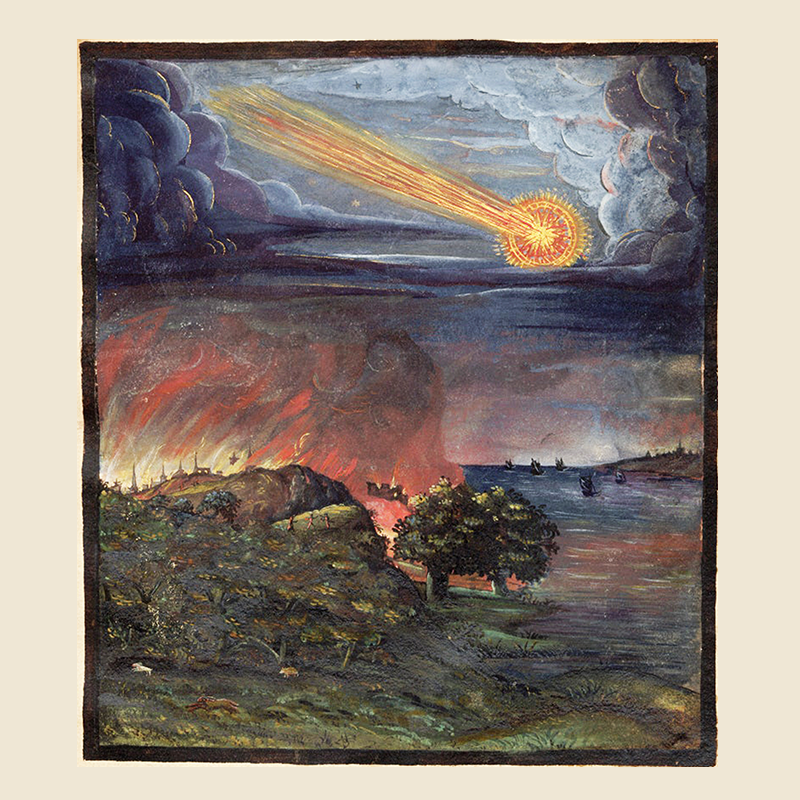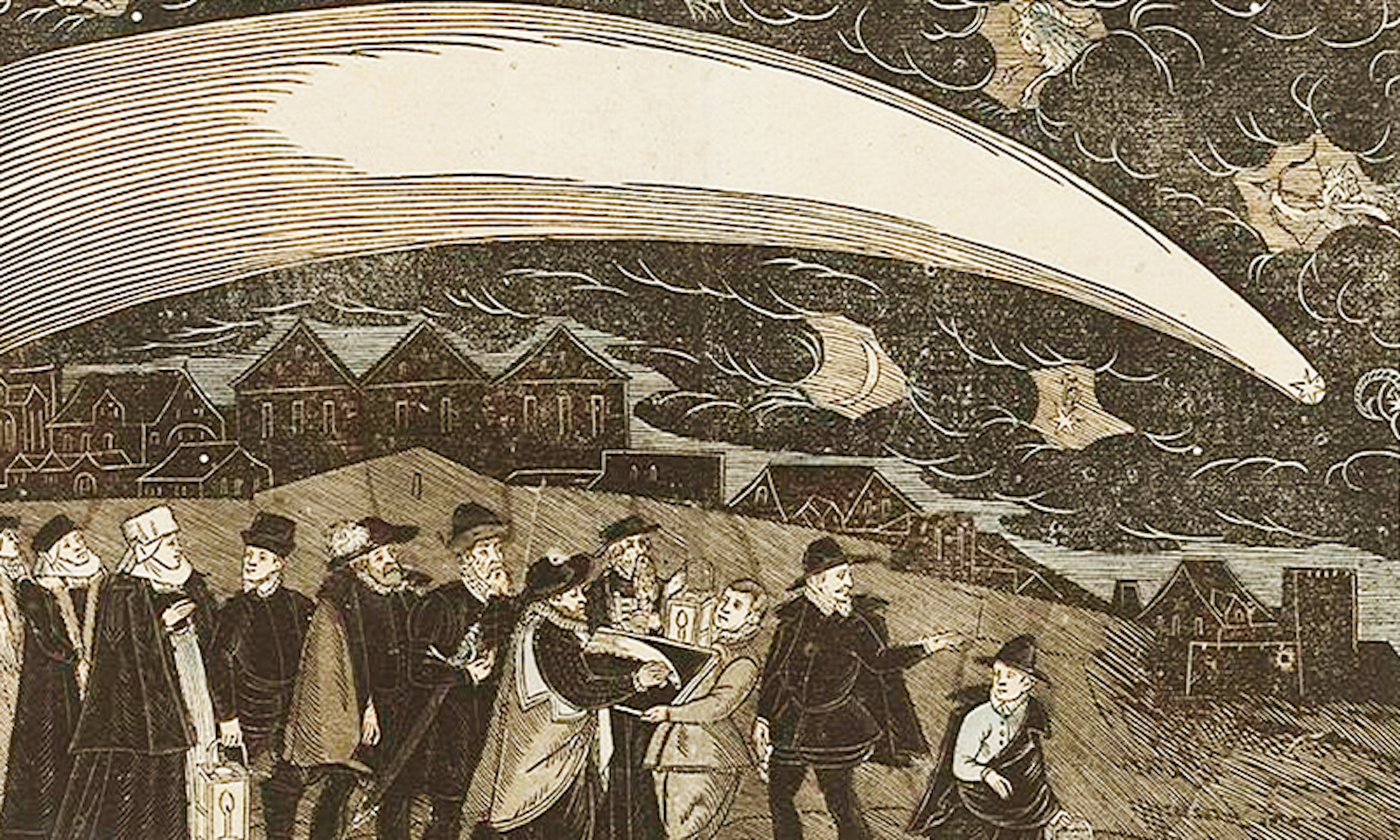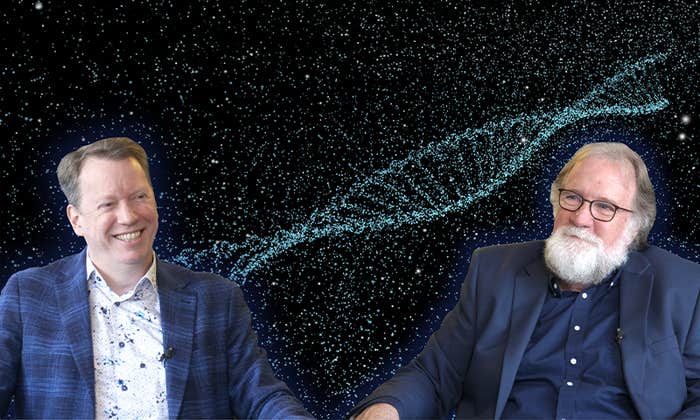One evening during the first pandemic summer, I stepped outside to see if I could spy the comet. C/2020 F3, a celestial crag of ice known as NEOWISE, was the first comet clearly visible to the naked eye since Hale-Bopp in 1997. I found it below Ursa Major. Its plume—a massive spray of indigo gas, dust, and red sodium—was as magnificent as a peacock’s feather. Chinese astronomers, in the first recorded observation of a comet in 613 B.C., called it a “broom star.” The Greeks called them komētēs, “long-haired” stars.
Not long before, my wife had been reading Middlemarch and shared an arresting line with me: “Things will grow and ripen as if it were a comet year, and the public temper will soon get to a cometary heat.” I had never heard of a comet year, but it seemed we had found ourselves in one. It certainly felt like the temper of things was heating up, as protests for racial justice took place across the country, the political gulf grew ever wider, and coronavirus cases surged in wave after wave.
Fault lines that fragmented the country are quieter now—but they’re still here.
In Boston, where I was then working as an emergency physician, we were inundated with critically ill COVID-19 patients. On some shifts I would walk from one room to another, intubating people. For those who didn’t make it, the last thing they saw was me, standing over them in a yellow gown and green respirator, the blade of the laryngoscope that I would use to intubate them in my hand. When paramedics brought us patients with COVID symptoms, they would sometimes throw a sheet over their heads as they wheeled them in, to keep the virus down as if it were dust. We didn’t know if we would run out of personal protective equipment, or how many would die. We didn’t know anything.
It was fitting that a comet should have appeared in the midst of that crisis year. The arrival of a comet has often been seen as a sign of what Shakespeare called a “change of times and states.” One appeared just after the assassination of Julius Caesar in 44 B.C. The comet of 1066, which appears in the Bayeux tapestry, was believed to have prefigured the death of King Harold and the Norman conquest of England. Charles V, ruler of the Holy Roman Empire, was spooked enough by the sight of a comet in 1556 to abdicate his throne. “By this dread sign my fates do summon me!” he said, before retiring to a monastery in Spain.
In colonial America, Increase Mather railed against the comet of 1680, calling it “heaven’s alarm for the world.” Tolstoy recalled “the enormous and brilliant comet” of 1811 in War and Peace, “which was said to portend all kinds of woes and the end of the world.” Many believed that Tolstoy’s comet foretold Napoleon’s defeat in Russia the following year. Disaster, after all, means ill-starred. As late as 1874, The New York Times reported that comets had been blamed for foul weather at Saratoga, fogs off Newfoundland, an epidemic among the cats of Westphalia, and “marvelous flights of wild pigeons in our own country.”
Of course, comets have nothing to do with any of these things. Psychologists have explained that the impulse to ascribe significance to the appearance of a comet derives from a deep human need for control. Projecting meaning upon the stars is a way of asserting a sense of autonomy over an enigmatic world, and of grappling with our own discomfort with the unknown. A story is always a comfort when something unexpected happens.
In the summer of 2020, no one was pointing to the sky to explain the chaos. But just as comets elicited wild stories to make sense of changing times and states, so too did the pandemic. While many heeded public health directives and tried to ground themselves in science, others turned toward conspiracy theories. Radically divergent stories emerged around every aspect of the pandemic, from lockdowns and vaccine mandates to the virus and vaccines themselves. But the most memorable and visible symbol of this divide, to me, were masks.
At the height of the pandemic, masks were everywhere. They tumbled down sidewalks like leaves and swung from rearview mirrors in cars. I saw them littering the ground at remote trailheads and looped from a branch like a lost mitten. And perhaps no other facet of the pandemic, other than vaccination, generated as much argument and vitriol as whether we should wear a mask. The competing storylines that emerged around masks embodied the way that the virus fractured our collective reality and frustrated our attempts to control it.

When the pandemic began, nearly everyone in Massachusetts wore a mask. That September my wife and I moved to Colorado, and masks dwindled as we drove westward. By Rolla, Missouri, not a single person wore one as I paid for gas. After crossing maskless Arkansas, I was surprised to find a gas station in Texas full of them. The attendant rolled her eyes and told me that the governor had just announced a mandate. She pulled her mask down, as if to let me in on something. “Everyone knows they don’t work,” she said, leaning across the counter toward me.
The division intensified as the pandemic wore on. In November 2020 my wife and I pulled into another gas station, this time in eastern California, on an isolated strip of I-40 punctuated by towns with names like Siberia and Needles. A woman approached me as I pumped gas, and asked if I would fill up her tank, too. She did not wear a mask, despite a statewide mandate in effect.
“Did you lose your wallet?” I asked.
“No, it’s worse than that,” she said.
I waited for her to elaborate as the pump chugged beside us.
“I can’t work because of what that man on the internet says.”
The pump clicked off.
“What do you mean?” I said. “What man?”
But she shook her head and wouldn’t say more.
I offered to put $10 in her tank and set my pump nozzle back in its cradle. As I followed her over to her car, I heard her mutter something under her breath. It sounded like she had called me a son-of-a-bitch. I confronted her about it.
“Oh, goodness no!” she gushed, flashing a smile. “I would never say something like that.”
“Why aren’t you wearing a mask?” I asked. “You’re putting everyone around you at risk, including me.”
“Wearing one is a risk to me,” she spat back.
I wanted to tell her that whatever she had heard or read was wrong. That I had seen people die from COVID-19, and that masks were safe and effective. I wanted to tell her that I was counting on her to protect herself and others by following public health guidelines, and that the virus was awful and real. I wanted to tell her that the hospitals were almost full, and that the worst was yet to come. But the gulf that yawned between us felt insurmountable.
“Verifiable knowledge makes its way slowly, and only under cultivation,” Wallace Stegner wrote in 1953, “but fable has burrs and feet and claws and wings and an indestructible sheath like weed-seed, and can be carried almost anywhere and take root without the benefit of soil or water.”
I wanted to start pulling up weeds, there in the eastern California desert, but I didn’t. I was tired, and we still had a long way to go.
“I’m sorry,” I said. “I don’t think I can buy you gas after all.” I set her nozzle back in its cradle and stepped between the pump islands toward my car.
“You know what,” she yelled at me as I went. “I did call you a son-of-a-bitch!”
In the deep past, comets themselves were invoked to explain outbreaks of infectious disease. “Witchcraft, demons, gods, comets, earthquakes were the first unproved theories” of disease, according to a modern team of medical historians.1 The Roman poet and astrologer Marcus Manilius wrote in the first century A.D. that “death comes with those celestial torches,” after a plague ravaged Athens. But by the fifth century B.C., Hippocrates began to articulate the first down-to-earth theory of infectious disease. He proposed that poisonous vapors called miasma were responsible. The theory was wrong, but the idea was pivotal—the idea that environmental factors were involved in disease allowed for the possibility of rational intervention.
The miasma theory of disease remained preeminent for centuries (it influenced sanitation projects in London as late as the 19th century), but astute observers noted that person-to-person transmission seemed to occur, something miasma couldn’t explain. Aretaeus of Cappadocia, an ancient Greek physician, noted correctly that leprosy could be transmitted through the breath. In 1362, amidst an outbreak of plague, the Moorish polymath Ibn al-Khatib wrote that the existence of contagion was proven by “transmission by garments, vessels, earrings; by the spread of it by persons from one house, [or] by infection of a healthy seaport by an arrival from an infected land.”
“You know what,” she yelled at me. “I did call you a son-of-a-bitch!”
These early writings contained kernels of truth, but it would be another 500 years before Louis Pasteur advanced the idea that microorganisms were the cause of many common diseases. Pasteur’s work precipitated a flood of new discoveries. By 1890, the bacteria that caused tuberculosis, cholera, and anthrax had all been identified. The German scientist Carl Flügge demonstrated the transmission of bacteria through the breath. Meanwhile, Russian microbiologist Dmitri Ivanowski uncovered a new kind of infectious agent he called viruses, from the Latin, meaning venom.
After 2,500 years of careful observation, enough understanding had been cultivated to interfere with nature intelligently. Flügge began collaborating with Jan Mikulicz-Radeki, a surgeon working to improve sterilization. Flügge’s experiments suggested that speech could transmit bacteria into a surgical wound, and he suggested that Mikulicz-Radeki devise a covering for his mouth. Mikulicz-Radeki fashioned “a piece of gauze tied by two strings to the cap, and sweeping across the face so as to cover the nose and mouth and beard.” He called it a mundbinde, or mouth-tie. It was the first surgical face mask. By 1919 they had become standard operating room attire.
In 1904, the American physician Alice Hamilton applied Flügge’s techniques to scarlet fever, a disease caused by streptococcal infection of the throat. Hamilton confirmed that infected patients could spread streptococci by coughing, or even just by breathing. She suggested that a gauze mask could be worn by patients with scarlet fever to protect other patients and staff. Hamilton’s experiments led her to a vital question. It was known that healthy people were sometimes colonized with strep. Could they also spread the bacteria, in the absence of symptoms? “Apparently the idea is a new one,” Hamilton noted. She set up a series of glass plates and had 46 colonized nurses and physicians cough over them. All but 10 yielded positive cultures. Hamilton had demonstrated the possibility of asymptomatic spread.

Not everyone accepted the theory of airborne transmission, or the new measures to curtail it. In the 19th century, Austrian surgeon Alexander Fraenkel lambasted the “whole surgical costume with a bonnet, mouth mask, and veil,” and believed that the “new fashion of the surgeon in gloves” was predicated on an “apparatus of pseudoscience.” In 1910, public health researcher Charles Chapin wrote that “there is no evidence that [airborne transmission] is an appreciable factor in the maintenance of most of our common contagious diseases.” He recommended “discarding it as a working hypothesis.”
Mikulicz and Hamilton focused on the use of masks to protect others from the infectious plume of a cough or sneeze. George Weaver, a colleague of Hamilton’s, “turned the perspective around,” according to Don Nakayama, a surgeon and medical historian. “He reasoned that masks might protect nurses and doctors from infectious diseases harbored by their patients.”
In 1916, Weaver implemented mandatory masking for nurses caring for patients with meningitis, scarlet fever, and diphtheria. Such nurses often contracted these illnesses, but by January 1918, infections among nurses had dropped to zero. Just weeks after Weaver published his results a virulent strain of influenza, whose name originally invoked the influence of malignant stars, surfaced at a military post in Kansas. It became known as the Spanish Flu and infected a third of the world’s population, killing tens of millions. But for the first time, people could do something to protect themselves. They could wear a mask.
Donald Trump, at a town hall before the 2020 election, remarked that “with the masks, you know, you have two stories.” The implication, it seemed, was that scientists simply told their own stories, and that beliefs opposing the use of masks were legitimate alternatives. Science is in fact a story that we create about the world, albeit one with strict rules. But the alternative stories that arose around masks, like those that were told about lockdowns or vaccines, became increasingly unmoored from reality as the pandemic progressed.
Russell Blaylock, a retired neurosurgeon, asserted in May of 2020 that masks “can reduce blood oxygenation as much as 20 percent, which can lead to loss of consciousness” or even “serious life-threatening complications.” (A 2021 study found no effect of masks on oxygen or carbon dioxide levels.2) He claimed that masks could somehow turbocharge a COVID infection, making the wearer even sicker. Judy Mikovits, a former research scientist who has promoted a variety of discredited ideas, claimed that “wearing the mask literally activates your own virus. You’re getting sick from your own reactivated coronavirus expressions.”
That spring, a member of our extended family, who was a tenured professor at a major university, began promoting conspiracy theories on a family email thread. He dismissed COVID as harmless and attacked public health measures, like mask mandates or lockdowns, as a destructive overreaction. When I told him I had seen people die from COVID, he said that infection with the coronavirus was a “marker” for other diseases, like diabetes, which was what was killing people.
Science is in fact a story that we create about the world—one with strict rules.
Other claims were more sinister, or even supernatural. “All Democrat states are under a form of ‘Medical Martial Law,’” wrote a Twitter user. On Facebook, a former candidate for governor in Missouri wrote that mask mandates were “part of a demonic ritual to get rid of our individual God-given rights.” At a hearing on mask mandates in Florida, a woman accused the local government of “obeying the devil’s laws.” And in Washington state, protestors gathered at the home of a public health official, toting signs that read “Masking is a satanic ritual.”
America has never been immune to conspiratorial ideas like these. In 1964, the historian Richard Hofstadter traced a conspiratorial braid running deep through American history. In 1855, he reminds us, a newspaper reported that “the Monarchs of Europe … are at this very moment plotting our destruction;” an 1895 pamphlet avowed that “the secret cabals of the international gold ring” had deployed “every device of treachery;” and in 1951, Senator Joseph McCarthy claimed knowledge of “a great conspiracy on a scale so immense as to dwarf any previous such venture in the history of man.”
In 2019, a review of 96 studies explored the psychological gears behind these patterns.3 People “tend to conspiracies” when they “fear a threatening situation, or have low perceived feelings of control,” the authors found. Two psychologists argued in 2017 that crises are especially potent drivers of conspiracy: “Since people have a fundamental need to understand why events occur,” they write, “crisis situations often elicit sense-making narratives.”4 In January, researchers found that a sense of diminished control also leads to increased support for political leaders who use conspiratorial rhetoric.5 It’s understandable that people would turn to stories like these in times of uncertainty. Reality is complex and nuanced. It is itself uncertain. A good story, on the other hand, can be simple and direct, and most importantly, certain.
This tendency seems to be latent in human nature, arising in times of crisis and not altogether uncommon. But the prevalence of paranoia generated by the pandemic is remarkable. In 2020, pollsters surveyed Americans on 22 conspiracy theories.6 Only 9 percent of respondents endorsed none. Nanobots in COVID vaccines alter your DNA, 5G cellular networks weaken your immune system, SARS-CoV-2 was a secret bioweapon—it was as though, in the words of the poet George Bradley, the pandemic summer’s comet had “set its blazing match head to the straw of human intellect.”
During the Enlightenment, comets prompted another, more careful, reaction, in addition to stories of doom and disaster. In 1680, Isaac Newton honed his laws of planetary motion and gravitation through observations of the comet of that year. He discovered that comets were drawn from the far reaches of the solar system by the sun’s gravitation. According to astronomer D.W. Hughes, Newton’s magnum opus, Principia Mathematica, is essentially a “textbook on comets.”
In 1705, Edmond Halley used Newton’s laws to prove that comets were predictable natural phenomena with orbits and periods. He demonstrated that several historical comets, including those that had appeared to Louis the Pious in 837 and over England in 1066, were in fact one comet, due again in 53 years. He was proven right on Christmas, 1758, when Halley’s comet returned to the sky. It marked the ascendance of a different means of achieving control, enacted through the scientific method rather than superstition.

For centuries, the careful methodology of science and reason gained ground over the medieval patterns of thought that supposed a comet could herald the death of a king. Why have huge swaths of the population now turned back toward the cognitive dark ages? Hofstadter suspected that “certain historical catastrophes or frustrations” could allow conspiratorial thinking to be fashioned “into mass movements or political parties.” While any number of economic, social, and cultural tributaries have fed the roiling current of partisanship that now grips the country, one development seems key.
The integration of the internet into every aspect of our lives appears to have exploded the human propensity to tell a story, any story, to cope with the stress of the pandemic. Nearly half of all Americans get their news from social media.7 But social media can insulate users from conflicting ideas, refracting and reinforcing their view of the world and creating schizophrenic streams of reality.
What’s worse, these platforms actively sort and select for radical content. The algorithms that power social media prioritize user engagement above all else. Content that is extreme, like a conspiracy theory, is more likely to hold our attention, and so the algorithm is more likely to recommend it. When you’re driving on the highway, it’s almost impossible not to look at a car crash. The same is true for being on social media, Tristan Harris, cofounder of the Center for Humane Technology, has said. So Facebook and Google feed readers “car crashes after car crashes.”
It’s tempting to believe that the end of the pandemic will signal the end of these car-crash narratives. But I’m not sure. Although the fault lines that fragmented the country at the height of the crisis are quieter now, they’re still here.
Recently I heard from a colleague about a patient in Oregon who refused a blood transfusion because the patient would only agree to accept blood from unvaccinated donors. Sixty-three percent of Republican voters still believe the 2020 election was stolen.8 In 2023, United States senators have made a host of debunked claims: The government is covering up problems with COVID treatments, liberal financier George Soros is bankrolling people to turn America into a third-world country, Putin is colluding with environmental activists to undermine American energy. The dark side of storytelling, the side that sacrifices truth to soothe uncertainty, or to project power, appears to be in permanent ascendance, hastened by our technologies.
Aza Raskin, also a cofounder of the Center for Humane Technology, has said we may be approaching what he calls the “vanishing point of human authority, where our minds are no longer an instrument to discern reality” because technology now exploits “our weaknesses for discerning what’s true.” Have we already crossed this threshold?
I work in a rural hospital in western New Mexico now, in a county that had one of the highest COVID death rates in the country. We’re no longer seeing patients in tents in the parking lot, by the light of propane heaters, like we were during the first pandemic winter. We’re no longer calling more than 60 hospitals, from South Dakota to California, to try to find beds for our critical COVID patients, as we were during the Delta surge. It’s been months since I took care of a patient with severe COVID. When the radio calls come in, popping with static, it’s chest pain and car accidents again, instead of fever, cough, and shortness of breath. The emergency department seems almost back to normal, except for the masks that patients and staff still wear.
We had the tools to limit the spread of the virus, but we didn’t. It wasn’t because of the comet’s malign influence, as might have been said 500 years ago. It was because we couldn’t agree on the story. Scientists, physicians, and public health officials had one story, painstakingly cultivated, and developed over time. Too many people in power told a different story, to deflect responsibility for the crisis. Millions of people, meanwhile, fell prey to the cognitive trap that led people in the past to blame comets for the calamities of their times—to project a story onto the natural world, to provide a sense of control when everything around them seemed out of control.
The impulse to sooth uncertainty with a story, no matter its provenance, must be nearly as old as the mind itself. Like any adaptation, it has been an asset as well as a liability. But in the era of the internet, this liability seems at risk of overtaking the more measured approach that the Enlightenment gave us. And that may prove more consequential than anyone has yet imagined, as the planet lurches toward its next calamity. ![]()
Clayton Dalton is a writer in New Mexico, where he works as an emergency physician.
References
1. Karamanou, M., Panayiotakpolous, G., Tsoucalas, G., Kousoulis, A.A., & Androutsos, G. From miasmas to germs: A historical approach to theories of infectious disease transmission. Le Infezioni in Medicina 1, 52-56 (2012).
2. Samannan, R., Holt, G., Calderon-Candelario, R., Mirsaeidi, M., & Campos, M. Effect of face masks on gas exchange in healthy persons and patients with chronic obstructive pulmonary disease. Annals of the American Thoracic Society 18, 541-544 (2021).
3. Goreis, A. & Voracek, M. A systematic review and meta-analysis of psychological research on conspiracy beliefs: Field characteristics, measurement instruments, and associations with personality traits. Frontiers in Psychology 10 (2019).
4. van Prooijen, J.-W. & Douglas, K.M. Conspiracy theories as part of history: The role of societal crisis situations. Memory Studies 10, 323-333 (2017).
5. Dow, B.J., Wang, C.S., & Whitson, J.A. Support for leaders who use conspiratorial rhetoric: The role of personal control and political identity. Journal of Experimental Social Psychology 104, 104403 (2023).
6. Uscinski, J.E. & Enders, A.M. The coronavirus conspiracy boom. The Atlantic (2020).
7. Walker, M. & Matsa, K.E. News consumption across social media in 2021. Pew Research Center (2021).
8. Survey conducted for CNN by SSRS Opinion Panel (March, 2023).
Note on the art: All the comet illustrations are in the public domain. Thanks to The Public Domain Review, where we discovered them. The opening illustration is a 16th-century woodcut of The Great Comet of 1577. The Great Comet of 1881, streaming over an observatory, is from a 19th-century book of astronomical drawings. The others are from The Comet Book, a 16th-century treatise, held at Universitätsbibliothek Kassel, on the meanings of comets.


























